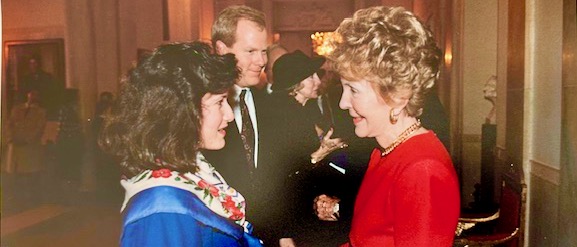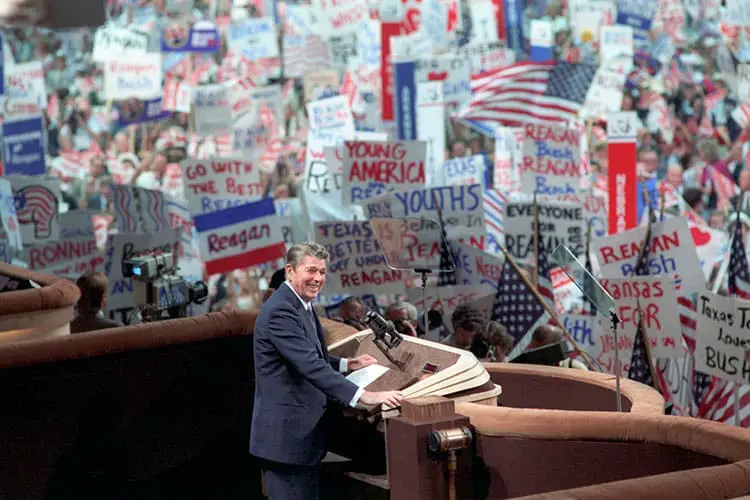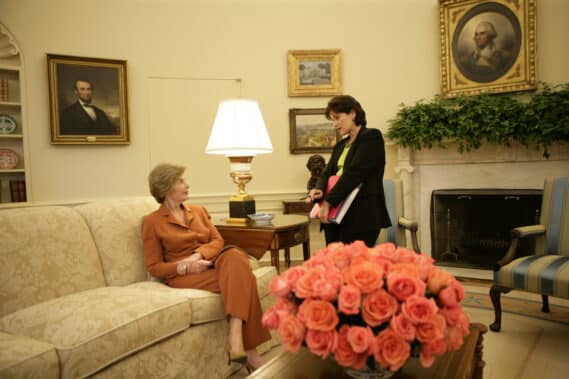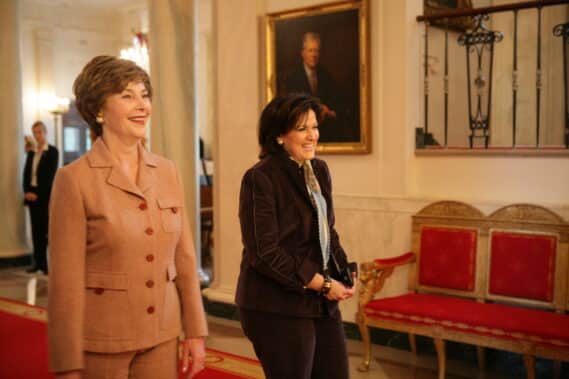
Photo credit: Courtesy of Anita McBride
According to historians, the term “First Lady” is used to refer to the wife of the President of the United States. The history of the term can be traced back to the early to mid-19th century with the first documented use of the term attributed to President Zachary Taylor who is believed to have used it in a eulogy for Dolley Madison at her funeral in 1849. Dolley Madison was the wife of President James Madison and she played a prominent role as the hostess of the White House during her husband’s presidency. While the term “First Lady” was used informally before Taylor’s eulogy, his use of it helped popularize and establish it as a recognized title for the President’s wife. The role of the First Lady has evolved over the years, with each occupant of the position bringing their unique style and focus to the role and they can have a significant impact on public opinion and national conversations.
Photo credit: Courtesy of Pinterest.co.uk
Following the recent death of former First Lady Rosalynn Carter and the impactful memorial service, there has been a notable increase in curiosity surrounding First Ladies. This heightened interest extends to Anita McBride’s co-authored book with Diana B. Carlin and Nancy Kegan Smith aptly titled “U.S. First Ladies: Making History and Leaving Legacies,” published by Cognella Academic Publishing. Forward by Dr. Jill Biden.
About the book: Filling a gap in academic literature, U.S. First Ladies examines how First Ladies are uniquely positioned to influence American society, public policy, politics, diplomacy, and life in the White House.
Text book version
That curiosity extended to Hollywood on the Potomac, so we sat down with Anita exploring her personal experiences and gaining insights into history. For every young person wondering how one gets to work in The White House, we sought the answers during our interview.
TIP # 1 Volunteer

8/23/1984 President Reagan giving his acceptance speech at the Republican National Convention in Dallas Texas. Courtesy of The Reagan Library
Anita McBride with First Lady Nancy Reagan
TIP #2 – Work you way up
“So I got hired to the lowliest of positions. It was in the presidential correspondence office. The woman who was running the operation, Ann Higgins, hired a lot of young people to come and be correspondence analysts. And I’d been recommended to her by someone at the campaign. And she was hiring a bunch of young people that came out of the campaign. And this is what we were doing. We were opening up mail and reading the mail that came into the President and giving it its proper disposition, whether it was mail that went to an agency to be answered or would go in the presidential section. In fact, the woman who trained me on how to read mail was hired in the last months of the FDR administration. She had been there since 1944/45 and was for 40 years, training people like me how to read the mail. That’s how I got started.”
The Office of Presidential Correspondence is one of the largest and oldest offices in The White House. Presidential Correspondence is responsible for processing all mail, email, and parcels addressed to The President of the United States. The office mission is to listen to the writers’ views, experiences, and ideas and coordinate an automated response on behalf of The White House. In addition to full-time staff, The Office of Presidential Correspondence retains dozens of interns and volunteers who assist in correspondence analysis, digital response, and The White House Comment Line. (Courtesy of Wikipedia)
Photo credit: Courtesy of The White House
“It was interesting. What was fascinating to me was you’re hearing from people all over the country – someone struggling in West Virginia or someone mad at the President in Berlin, Germany. You heard incredible cross sections of how the public feels about The President and his decisions. I loved it because it was sort of your finger on the pulse of how people were thinking, how citizens of the country were thinking. Only a fraction of people in the country will ever meet The President, will ever get to the White House, will ever come close, but they could write to The President and they can complain and he would see it or they can tell him they thought he was doing a great job and he could see that too. So it was an interesting way to get started and kind of a real reminder we’re there to serve the public and the public has the right to tell you how they think about how you’re doing your job.”
“This is in the basement of the Old Executive Office Building. The President went down to see the WH Telephone Operators who he loved and I grabbed my two staff from the personnel office to run down to see him.”
“These are when I went out to California for the former President’s 80th birthday in 1991 and visited him in his office. He signed my copy of his memoir.”
On the legacy of First Lady Barbara Bush
“So I started in the White House in 1984. I was really one of the few people, truly a handful of people, that were kept for the next administration for the George H.W. Bush administration. By the time he came in, I had moved on to another job. I was in management administration, I was in personnel. I helped really handle the transition – the transition out of the Reagan people and the transition in of the Bush people, so the new team knew me too from helping them get ready to transition in. I was very fortunate to be asked to stay. And so I served as Director of Personnel almost that entire four years of the George H.W. Bush administration. It was about a year and a half into the administration when I started dating Tim (McBride) and Tim had been President Bush’s and Vice President Bush’s personal aid, one of the longest serving people who served in that position, so he’s quite close to them. They really loved Tim. They admired him greatly. They were greatly interested in me when we started seriously dating.”
TIP #4 – Skip the dating apps, just look around you….
“They were very interested in people’s love lives. And in fact, when we got engaged in 1992, Tim had left The White House by that point, but I was still there. Barbara Bush came over to see my engagement ring. It was so funny. I mean, I just think they liked to see that people were happy working there and meeting each other. And so we got married that year before the reelection, of course, when he lost. That was difficult. So that’s how I got to know her. It was really through my husband.”
January 1993 – Departure photo
On the legacy of First Lady Barbara Bush
“I think from the substantive point of view and the contributions on her issues, literacy of course stands as number one. The foundation that she created just months after becoming First Lady is still in existence – The Barbara Bush Foundation for Family Literacy. She spent really her public life since she was Second Lady raising money, raising awareness on literacy and it stood the test of time. But I think the other things for which Barbara Bush is known and should be known is her candor, her honesty, her loyalty to friends and family. This is a woman who is comfortable in who she was, would speak her mind. When she died, 8,000 people went to her funeral and she was eulogized by John Meacham as The First lady of The Greatest Generation. The women from that era – the Rosalyn Carters, the Barbara Bushes, the World War II wives – they are about service. That’s who they were, but she was faulted throughout her life too, for technically not having a life of her own. She was 19 years old when she married George Bush. She dropped out of college, but never regretted that, but used her platform when to make a difference, but always being herself. So I think that she should be and is known for that as well.”
“In Kennebunkport with my kids. Barbara loved to take her own pictures and send them around.”
Christmas photos with the Bushes 1989,1990,1991
On the Legacy of First Lady Laura Bush
“She’s from the West Texas prairie. It’s the boom and bust towns of West Texas. There’s no pretensions of the people there. She is grounded. She’s confident in who she is. She was an only child in a nonpolitical family that enters into this incredibly dynastic political family, but never lost a sense of who she was. She is also dedicated to literacy and education and was a teacher in multiple inner city schools, became a librarian because kids needed to read in order to thrive. She devoted her life to education and literacy and has left things behind like The National Book Festival which is now in it’s 25th year. She wants people, particularly young kids, to love books. I think too she was herself, she never felt she had to put on any pretensions and she was just thrust into a situation she could not have predicted, of course, 9/11.”

President Bush, Laura Bush: Meeting on Efforts to Assist Students and School Districts Affected by Hurricane Katrina. Oval Office. Mrs. Bush talks alone with Anita McBride before the meeting.
“And how she responded to that – she just sort of threw her arms around the nation and she brought a sense of calm. The comforter in chief, as she was noted by the press. And she drew from her own inner reserves to know how to do that as a mother herself and how parents would be feeling about the fear that their kids would have after such a trauma like that. And telling people just to turn off the TV and let kids know that they’re safe. You can’t teach somebody those kind of instincts. That’s just are who they are. And I will say this about working with her directly, Laura Bush never lost her cool. She just had a tremendous sense of calm about her resilience, which made it very, very easy to work for someone like that. She was serious about the work that she did. She had high standards. We never wanted to disappoint her, but she never lost her cool. In fact, I always describe Laura Bush as having the innate political skill of knowing how and when to turn down the heat rather than turn it up.”

Laura Bush: 2006 National Book Festival Authors’ Breakfast and Opening Ceremony. Mrs. Bush and Anita McBride in the Cross Hall before entering the East Room.
First Ladies that deserve accolades according to Anita
First Lady Rosalyn Carter
“Rosalyn Carter was a remarkable First Lady and was underrated for many years. We saw this at her funeral and that’s really too bad, but at least it’s still not too late for people to understand the contributions that she made as a First Lady of Georgia, number one. She tackled the mental health issues. She chaired The Mental Health Commission for the state of Georgia. The President wanted her to do the same at the national level. When they came here to Washington, they ran into a bit of a buzz because at the time, the rules did not allow for The President to hire a member of his family. And so what she had to accept was a title she did not want which was Honorary Chair of The President’s Mental Health Commission because she thought it conveyed someone who went around cutting ribbons and did not take into account the depth of knowledge that she had on this issue, but she did it.”
Courtesy of The Carter Center
“She was one of only three or four first ladies in our history that testified before Congress with her findings. She was relentless about this issue and she drew from a personal experience of understanding the mental health needs of our nation. She was a young girl, a teenager when her mother died and she had part responsibility for helping to raise her brothers. She writes about it in her memoir. She would go sit where she grew up in an outdoor privy. She would go sit in there and cry under the weight and the pressure of this responsibility. So when she was in a position, a public service position as First Lady of State and then of the nation, she used that experience to try and help address a real critical need. I think the other things too, which I’m grateful for, and anybody who’s worked in a modern First Lady’s office is grateful for, because of this issue that she ran into that she couldn’t officially sort of be hired she created her own position.”
Courtesy of Alamy.com stock photo testifying
“There were changes to the personnel system in The White House during the Carter administration. The White House Personnel Authorization Act in 1978 allowed for the first time for there to be an official office of The First Lady with a budget assigned to it, staff members assigned to it. The staff still had to be considered staff of The President of the United States assigned to The First Lady, but it was now an official codified structure for The Office of First Lady. She was the first lady to move her actual physical office into the East Wing. Prior to that First Ladies worked up in the residence in their dressing room. She wanted to be where her staff was. She hired a policy director. It was the precursor, really.”
Camp David courtesy of TheFrederickPost.com
“But Rosalyn Carter helped to put that structure in place for the modern First Ladies office. That’s one aspect of White House history and legacy that she left behind as well as her mental health work. And also, the other thing is too, which people really didn’t realize her, she had such a close relationship with her husband and he trusted her. He valued her opinion. During the Camp David Peace Accords, she sat in on those sessions and those meetings with Sadat and she took copious notes, real time notes, over 200 typed pages that really showed, as she said in her memoirs, the seesaw of emotions during those meetings. She had a front row seat to that just really remarkable event. And her first overseas trip that she went to was Latin America. She went to seven countries. The State Department didn’t want her to go. They said the macho leaders of these countries are not going to listen to you. But she went, she spoke Spanish, she met on substantive issues, human rights issues, security issues. At the end of that seven day swing, she opened doors for our diplomats with these leaders of Latin America when this was a period of time that was very fraught with tensions between the US and Latin America – the imperialist North Americans trying to get a foothold in Central America. She helped to open doors for our US diplomats who were so dismissive of her originally. She was a bold first lady.”
First Ladies Eleanor Roosevelt, Lady Bird Johnson, Jackie Kennedy, Michelle Obama, Hillary Clinton
“Eleanor Roosevelt, of course, will hold the standard bearer of the most activist First Lady in our history. Lady Bird Johnson made amazing contributions to our country. We really consider her to be the first environmental First Lady. She was also very courageous to take that train trip through the South at the height of the Civil Rights Battle for Civil Rights legislation, feeling that she as a southern woman could appeal to southern men in particular in a way that others couldn’t. And it was very courageous because there were bomb threats against that train trip. I think influential in terms of the standard of historic preservation, Jackie Kennedy for preservation of The White House and the legacy that she’s left behind with the White House Historical Association to preserve in perpetuity, not only the collections of The White House and the preservation of it culturally, but also the education arm of it.”
First Lady Eleanor Roosevelt Photo credit: Courtesy of Politico
First Lady, Lady Bird Johnson. Photo courtesy of Brittania
First Lady Jackie Kennedy. Photo courtesy of CBS News.
“You can’t ignore the Michelle Obama coming into the position as the first African-American First Lady, and what a turning point that was. I mean, I have to say our modern First Ladies have had enormous contributions. Hillary Clinton, the only First Lady in history to then run for public office, be a cabinet officer. It just shows the limits that keep getting pushed. Jill Biden as working outside the home, if you will. Other First ladies had jobs before they came into the White House, but she’s continued that. And again, that pushes limits. It just shows really the flexibility of this role. But each of them in our modern times really have left an imprint on the role, on the position, no doubt about it. Those that have served in wartime and have had different sort of pressures put on them. But I think if you’re telling me to choose the top four in the modern era, then the Eleanors, the Lady Birds, the Hillarys, the Michelle Obamas, it’s tough to ignore for the reasons I identified.”

First Lady Michelle Obama and former First Lady Laura Bush participate in a photo line prior to a conversation in support of the Joining Forces initiative, at the National Archives in Washington, D.C., Sept. 16, 2016.(Official White House Photo by Amanda Lucidon)
This photograph is provided by THE WHITE HOUSE as a courtesy
“Jill Biden’s quote that she gave us when we interviewed her for her book, she said, I felt I came into this role at a time where there was a lot of national trauma post Covid. The election was contentious. And rather than pick an individual issue, she said, I wanted to be a first lady that was there when she was needed and to be there for everyone, and no matter who voted for her husband. So I think, again, it’s an example. First ladies rise above the politics. That’s always good guidance to do that as best as you can. There’s plenty of politics going on in The White House or with The President and his staff, but to the degree that you can rise above that and let people, the nation, feel you are there for them no matter who they are, I think that’s a good guidepost.”
First Lady Dr. Jill Biden during Covid. Photo courtesy of The New York Times
“It really is of course, to remember that these are all imperfect people. And again, another thing too is our first 11 first families were slaveholders. That’s not (necessarily) a positive thing, but again, the country evolves. That’s always my point on this. When we want to sort of tear apart the figures of our history, they were products of their times. The country continues to evolve. That’s the responsibility of each generation to make it to better, to adapt, to modernize. And again, they’re imperfect people, but charged with the problems of the world that comes to your shoulders.”
If you were hired you to advise First Ladies going forward, what would you advise them to do?
“I think what I’ve observed in the ones that I’ve known and I’ve worked for directly and in the research now that I’ve done for every First Lady that we’ve had in our nation from Martha Washington forward, is they are best at this role when they draw from their own experiences, backgrounds, interests, because it’s authentic when they engage on issues that are based on something that they know something that could help other people. I love the quote that Barbara Bush said when she became First Lady, and I think this is a guiding light for all First Ladies, when she told her staff on the first day she met with them, I want to do something to help someone every single day. And that was her North Star. And that I think is a great guide for a First Lady. And I think also to be open to, of course, to the things you can’t predict, obviously a trauma that may hit the nation like a 9/11, like a hurricane Katrina. You have to be there.”
“Remember the First Ladies” trade version is due out this week.
Very last question: Would you like to wake up tomorrow and be First Lady?
“Well, knowing the good that it could do, if I could be someone that could help to make a contribution to our country and if that was the way to do it, sure. But what I really would rather do is help and support and promote how important this role is and help anyone who has the courage to do it.”